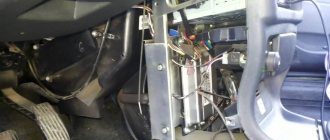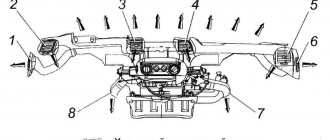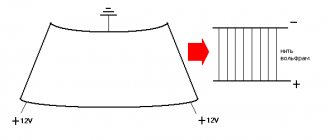03 February 2021 Lada.Online 37 526 4
During vehicle operation, owners may observe fogging of the windshield, rear windows, and side windows. The problem can occur at any time of the year, including winter or summer. We understand the main reasons for glass fogging. Let's find out what recommendations the manufacturer gives in this case.
Cabin filter
All modern cars, including domestic ones, are equipped with this (Chevrolet Niva is no exception). The cabin filter helps prevent dust and dirt from entering the vehicle. The manufacturer recommends replacing them once every 20 thousand kilometers. If the car is used in extreme conditions (for example, frequent driving on dirt roads), this period must be reduced to 8 thousand.
Some premium cars, for example the Mercedes S-Class, are equipped with a carbon cabin filter rather than a paper one. It fights pollution better, but its price is 10-15 times higher than usual. By the way, the replacement schedule is 50-100 thousand kilometers. A dirty cabin filter can reduce air flow in the ventilation system.
The body is twisted
If it's a matter of body geometry, you can't handle it yourself, unless you're a professional straightener. Straightening the geometry is a very delicate job; even fractions of a millimeter can be important here. If the glass leaks for this reason, there are no options - you need to look for a good straightener and prepare a tidy sum. Of course, it is worth straightening the geometry only if the cost of straightening does not exceed the cost of the car itself (and this also happens). It is worth correcting the body only if your car is new and not cheap.
Check the interior ventilation
A rare case, but sometimes it happens. After body repair of a damaged car at the rear, special ventilation valves can be sealed. In this case, the air circulation calculated by the engineers does not occur. Another variant of the same problem is an excessive amount of things in the cabin and trunk. The solution is to check the capacity of the air ducts by first studying their location according to the instructions. The same problem can be attributed to clogged drain holes in air conditioning systems. Standing water simply blows into the interior, and the situation can be corrected by simple cleaning.
Function of the EGR (exhaust gas) valve
When and in what quantities exhaust gases are sent to the external gas recirculation system is controlled through the exhaust gas recirculation valve - often called the exhaust gas recirculation valve (EGR) - or EGR.
The EGR valve usually consists of a poppet valve or a special gate valve. This valve releases or prevents the movement of exhaust gases into the engine intake tract.
Using sensors such as the mass air flow sensor and oxygen sensor (lambda probe), the engine control unit calculates the ideal amount of exhaust gas recirculation and accordingly controls the exhaust gas recirculation valve (EGR valve).
The mechanical movement of the EGR valve device is usually performed electro-pneumatically or electrically using a servomotor.
On some vehicles, the EGR valve is also equipped with a position sensor that monitors the correct opening and closing of the flap or pushrod. By the way, exhaust gas recirculation occurs only in the part-load region of the engine.
Heating system malfunction
There’s something interesting to say here, without further ado, let’s start right away:
- A banal reason. The stove has broken down and is not working, either the engine itself or the fuse has failed. Needs to be fixed. Next, we will assume that everything in our electrical system is working properly.
- The glass sweats a lot. There is a sweetish smell in the interior and in the mats of an unknown liquid. Here you are 100% either leaking the heater radiator or some pipes - hoses. Moreover, antifreeze or antifreeze penetrates into the cabin. You need to take everything apart and look. It is worth remembering that coolants contain either propylene glycol or ethylene glycol, in fact these are “simple” alcohols, they also evaporate quickly and your windows will simply SWEAT VERY MUCH, no stove or air conditioner will help you. YES, breathing ethylene glycol vapors (which is included in the composition of various antifreezes G11, G12 and ANTIFREEZE) is unsafe - IT IS TOXIC. So you need to quickly eliminate the leak (by the way, this can also lead to overheating of the engine)
- There is a coating on the glass, but every night it is greasy. This is not the kind of deposit that I described above; here, again, antifreeze or antifreeze is leaking somewhere. BUT not so much, one might say it oozes. Run your finger along the glass, if there is a greasy coating, then disassemble the panel, look at the stove - rods - pipes
- Cabin filter. I recently encountered this myself, one might say on a new car. The point is, at OPTIMA during the first maintenance, they may or may not change the cabin filter (by the way, this is the case for almost all brands). Personally, I didn’t change it, I said, leave this one - if I change something myself later (in the video version there will be instructions on how to do this). Well, as it becomes clear, it’s clogged with all sorts of dust and other “charms.” The glass began to sweat a little, it became especially noticeable at night, not much, but unpleasant! In general, we change the filter, performance is restored. Moreover, it seemed to me that the stove actually began to blow harder (you can see the filter was completely clogged).
Plaque on glass
From high mileage, as well as from malfunctions (more on them a little later), a certain coating can form on the glass. From breathing, from dust, etc. the glass can become overgrown with a thin film - a coating, of course, may not be so visible, but if the glass has not been wiped for a very long time, then it really looks like fogging.
The bottom line is, wipe and clean the glass at least once a year before the autumn-winter period. Moreover, this must be done with both the front and rear glass.
A LITTLE ADVICE . The plaque “sits” quite well; not every product and not every rag or napkin can remove it.
We take paper towels and ammonia (it can be diluted with water). Apply alcohol to a cloth (any cloth), wipe the surface, then wipe everything dry with paper towels.
If you can’t stand the smell of ammonia, then you just need to buy an optical cleaner (sold at any electronics store) and apply it. Then again, use paper towels to remove the plaque.
Well, now about the fight against fogging.
What to do if the windows are already fogged up
The most reliable, although not the fastest, is to warm up the engine and let the standard heater do its job. And in order not to waste your time on this, install an alarm system with an auto-start function on your car or an autonomous heater that works according to a timer, program, or is started remotely. By the time the driver and passengers arrive, there will be no traces left of interior frost and dew.
You can do it even simpler - wipe the glass, but not with a rag, since fogging will return immediately, but with a product that leaves a thin protective film. For example, with regular newspaper or a weak soap solution with a minimum of water. To maintain transparency, the protective layer will have to be rubbed.
Turning on the air conditioner will help dry the air. It can not only lower the temperature, but also remove excess moisture from the air. But on some cars it will not be possible to turn it on at low temperatures.
What the driver should do to prevent the windows from sweating: ways to fix the problem
So, having figured out the reasons why car windows often sweat, you can move on to what to do in such a situation. Of course, the easiest way is to buy a rag and constantly wipe the glass before driving.
You can also constantly turn on the stove, drying the interior. The downside is the long wait for the engine to warm up during a cold start and for the windows to fog up. True, you can constantly turn on the air conditioner (if available), which quickly “dries” the air and removes moisture, but fuel consumption increases, the life of the air conditioning system decreases, etc.
Moreover, this approach of removing moisture with a rag or using air conditioner does not solve the problem itself, but only allows you to get rid of the consequences. If you need a more effective solution, below we will look at ways to avoid fogging.
So, to prevent your car windows from sweating in winter, it is important to understand that the glass itself differs in quality and properties in different cars. It’s good if the car has laminated athermal glass
It’s even better when it is additionally possible to heat the car windows (heated rear window, windshield, etc.).
The presence of glass that is less prone to fogging, as well as their heating, allows you to quickly dry the windows in your car without turning on the heater or air conditioner. Also in winter, heating the windows allows you to quickly clear the outside of the windows from ice and snow. It turns out that if the problem of glass fogging is acute for the driver, this feature must be taken into account at the stage of selecting a car.
Let's move on. To reduce glass fogging, you also need to periodically service the heating and ventilation system of the car interior, check the operation of the stove, fan, etc. As mentioned above, you need to promptly change the cabin filter and turn off recirculation.
You can also stick a special film on the glass that resembles tinting. This film also has the property of preventing the accumulation of moisture on car windows. In addition, there is another solution - a defogging agent for car windows.
The so-called anti-fog agent for car windows is sold in liquid containers or spray cans. The composition is applied to pre-washed, dried and degreased glass. In practice, the solution is effective, but one application lasts only 10-15 days.
If desired, you can make your own anti-fog at home by mixing denatured or ethyl alcohol with glycerin. The proportions are 20:1, where 1 is glycerin. Then it is better to place the mixture in a spray bottle for ease of application.
A couple of practical tips
I have already talked about the anti-fog glass (read this article ). It can be made from usually foam or shaving gel. They form a film on the glass, and water vapor does not settle as much!
BUT there is another, effective way - silica gel. These are balls or crystals that are often placed in boxes with shoes. The fact is that it dries the air perfectly, removing moisture (water) from it.
You say, well, okay - “where can I get it, shouldn’t I buy shoes for this?” Guys, everything is simpler, there is cat litter, silicone - this is exactly this silica gel. It can be poured into an old but not holey sock (it is important that the sock is natural and not synthetic. Synthetics do not breathe). Well, put it under the seat. You can make small bags (there are a lot of them on sale now) and put them on the panel; they will also help to “anti-fog” the front window.
Now let's watch a useful video.
This is where I end, I think my article and advice were useful to you. Sincerely yours - AUTOBLOGGER.
(
10 votes, average: 4.90 out of 5)
During the operation of the car, the driver may encounter various inconveniences. At the same time, the real problem is those that affect not only comfort, but also safety. In practice, in some cases, the headlights may be too weak even after replacing the bulbs, which makes driving at night very difficult. In such a situation, you can solve the problem by polishing the headlights or replacing them.
At the same time, not everyone knows why car windows sweat. Next, we will look at the reasons for fogging of windows in a car, when fogged glass indicates possible malfunctions of the car, and also what to do if the windows in the car are sweating.
Read in this article
Test of folk and store-bought anti-fog glass remedies
- in the form of a special liquid that covers the glass with a transparent film that prevents the accumulation of water vapor condensation;
- in the form of mastic.
Anti-foggers in the form of mastic are the most expensive, but also the most effective. Mastic covers the glass and protects it from fogging and getting wet. One application of anti-fog in the form of mastic is enough for several trips in wet weather. There is also one rule to remember.
In winter, you can also use anti-freeze or a special Anti-Ice product for the car interior. These products are alcohol-based. Alcohol also prevents condensation from forming on the surface of the glass. In addition, you will not have ice forming on the glass from the inside at ambient temperatures down to minus 25 degrees Celsius. One application of such special products is enough for 72 hours.
The windows in the car fog up from the inside: what to do if all the car systems are in order, but you don’t want to constantly open the windows?
Anti-fog
Available in cylinders. The average price is 200 rubles. Prevents glass fogging and condensation.
Car windows sweat in winter: what to do?
Manufacturers assure that the product copes well with the task assigned to it even in the cold season. Its advantages:
- protects the surface from moisture without polluting it;
- can be applied to an already foggy surface without preliminary wiping;
- One application per month is enough.
To use the anti-fog, you need to shake the can, then spray its contents evenly onto the inner surface of the glass and rub with a napkin.
Anti-condensation ClearVue
An effective product that prevents condensation. Estimated cost – 300-400 rubles.
Its advantages:
- reliable protection;
- cost-effectiveness and ease of use;
- combined use with “Anti-rain” makes the glass more transparent, helping to improve visibility;
- Possibility of use in everyday life, and not just in the car.
Anti-fog Atas Rox
Advantages:
- low price (150-200 rubles);
- the composition contains antistatic particles that increase the effectiveness of the product;
- ensuring good visibility in any weather.
Do your car windows sweat when it rains? There is a solution!
Car windows sweat in the rain
- yes, it’s a well-known problem... And a very unpleasant one, since it interferes with safe and efficient driving. Why do car windows sweat when it rains and how to deal with it?
Ways to fight:
It is generally accepted that the best way to combat window fogging during rain is with an air conditioner or climate control system. Turning them on effectively eliminates the problem of foggy windows in just half a minute. The secret is simple - the air conditioner dries the air.
However, there are situations when it rains for several days in a row. Don't drive with the air conditioning on all the time. And to be honest, during the rainy season it’s no longer hot, to put it mildly. And in some cars, let’s be honest, a working air conditioner “takes away” quite a noticeable amount of “horses” from the engine, causing a certain discomfort. And on top of that, using air conditioning to combat window fogging often has a downside - when you turn off the air conditioner, the windows in your car begin to sweat again, often even more than before you turned it on.
Another very common cause of heavy fogging of windows in the rain can be a clogged cabin filter. Many car owners, after replacing the cabin filter for several months, forget about the problem of windows fogging up during rain.
But, unfortunately, this rule does not always work; a lot depends on the model of your car, the quality of its build and, in particular, the ventilation system.
Heating, which is equipped in many modern cars, helps a lot in the fight against fogging of the rear view glass. The same applies to the heated windshield.
The most ancient ancient method is to constantly wipe foggy windows with a rag. I wiped it, drove 300 meters, wiped it again. However, we will not seriously consider this method, since you can rub the windows endlessly, but they have been sweating and will continue to sweat all the way.
Need to remember.
- One of the first rules for combating window fogging in the rain is the correct setting of interior ventilation. First of all, you need to remember that in the rain you need to turn on the air intake from the street and direct the airflow onto the windows. If you leave the recirculation mode, that is, air intake from the cabin, the windows will begin to sweat even more. In especially severe cases, the airflow can be turned on to maximum. True, in some cars the sound of a running fan can drown out even the roar of the engine. But fighting window fogging requires sacrifice.
- A fairly effective way is to ventilate the interior. This allows you to equalize the inside and outside temperatures. However, driving in the rain with the windows open is not very comfortable. Firstly, it detects rain in the cabin, and secondly, if there are puddles on the street, then you can easily get a fair amount of dirt in your face from oncoming cars.
- Often, the reverse technique helps to cope with the problem we have identified - increasing the temperature in the cabin. To do this, you need to turn on the stove on heat and direct air from the deflectors to the windows, while slightly opening the window. Warm air will absorb moisture and the fogging of the windows will disappear. However, this does not always help.
Reason 1: high air humidity
The windshield fogs up not only in rainy weather. Condensation can also appear in dry weather. The reason is the high air humidity.
- Warm up the car without passengers.
- Turn on the external air intake.
- If the car has air conditioning, turn it on. Direct the air onto the glass. It is recommended to block the holes in the central part so that the condensation evaporates more quickly. Be careful! If it's cold outside, the flow of hot air can crack the glass. Therefore, this method is not suitable for everyone.
- Clean the inside of your glass frequently. First, clean them using auto chemicals, then wipe them dry without touching the glass with your hands.
- Use special auto chemicals to protect against condensation. Such products create a water-repellent film on glass. Choose products of good quality, otherwise you risk encountering greasy streaks that don’t dry out.
The windows in the car fog up: the main reasons
So, if the car windows sweat, it often happens in winter, during rain or fog, that is, in conditions of high humidity. Naturally, visibility in such conditions is usually poor, and if you add to this that the windshield, rear and side windows sweat, the risk of an accident increases significantly. It also happens that the cause of foggy windows is not only the weather. In any case, you need to know what to do in such a situation and what measures to take to prevent the car windows from sweating. Let's look at the causes and ways to fix the problem.
Let's start with the simplest one. First of all, in winter, windows sweat because condensation forms as a result of the interaction of warm air inside the cabin and cold air outside. This condensation settles on the glass, causing the car windows to fog up.
Glasses often sweat when it rains. As a rule, this happens due to the fact that the humidity in the cabin increases significantly. Moreover, moisture begins to actively evaporate from the wet clothes and shoes of the driver/passengers, as well as from the rugs after turning on the heater, and settles on the windows.
Now let's move on to the less obvious reasons why car windows sweat. For example, if there are passengers in the car who have recently consumed alcohol, then this is the reason why the car windows are sweating.
In fact, alcohol vapors exhaled by a person who drinks alcohol have the ability to absorb moisture, which causes it to settle on the car windows and fog up the car windows.
Also, problems in the interior ventilation system lead to fogging of the glass in a car. Often, we are talking about the interior air filter. Its contamination, defects, model mismatch or errors when installing the cabin filter cause the filter to not absorb moisture and dust properly. The result is foggy windows.
Another reason for window fogging can often be driver errors or malfunctions that do not allow fresh air from outside to penetrate into the cabin. First, many cars have a function to turn on air recirculation in the cabin without taking it in from the outside.
In fact, the damper blocks the flow of outside fresh air, and the air from the cabin circulates in a circle. In certain situations, this function is useful, as it allows you to avoid the entry of dust and unpleasant odors from the outside, the interior can be warmed up or cooled down faster by turning on recirculation, etc.
However, interior air recirculation should not be switched on all the time. If you close the flow of fresh air for a long time (20-40 minutes) or more, the windows will begin to actively sweat, and the driver and passengers may also feel drowsiness, deterioration, etc. The reason is a lack of oxygen, a noticeable increase in air humidity inside the cabin, etc.
If air recirculation is turned off, and the windows still sweat for no apparent reason, the valve through which fresh outside air enters the cabin may break. The sensor that controls the damper may also fail.
Let us also add that the cause of foggy windows in a car can be an unnoticeable leak of various technical fluids. As a rule, if a heater radiator (stove) or any pipe leaks, coolant can enter the cabin and evaporate, settling on the windows in the form of an oily mist.
It is necessary to study the features of the stove design on a specific car model, carry out diagnostics, etc. If the mat is noticeably wet on both the driver's and passenger's sides, you need to figure out what is leaking and where it is coming from. In this case, you need to take immediate action, since breathing antifreeze or antifreeze vapors is very harmful, serious problems with the engine cooling system are possible, problems with the clutch cannot be ruled out (if brake fluid leaks into your feet from the clutch drive), etc.
Useful tips
As you can see, in order for the car windows not to sweat in the rain or snow, an important condition is to ensure the most effective ventilation of the interior. In practice, sometimes, instead of waiting for the stove to dry out the moisture, it is better to open the windows a little.
To dry the rear window, you can turn on the heating. If this does not help, then you can install a small fan or interior heater that runs from a car outlet or cigarette lighter.
Also, you should not leave wet or damp things (umbrellas, shoes, jackets, etc.) inside the car. In this case, as it dries, moisture will settle on the glass. It is also recommended to drain the water and thoroughly wipe the rubber mats; heavily wet fabric mats should be removed from the car and dried separately.
Also, especially if the car is in high humidity conditions for a long time, you need to dry the entire interior. This can be done by placing the car in a warm garage or secure parking lot for several days with the windows slightly open.
If the windows sweat while driving and the heater and/or air conditioner cannot cope with the fogging, it is recommended to drive with the side windows slightly open. Also, if it’s hot in the cabin and cold and humid outside, after the trip it’s better to open all the doors for 5-10 minutes so that fresh air can enter the cabin.
Let us also add that if the driver is transporting passengers who have been drinking alcohol, so that the windows do not sweat, it is optimal to ask such passengers to talk less (if possible), since the alcohol vapor they exhale causes the windows to fog up.
Finally, we note that you should not try to remove frozen ice from the glass using windshield wipers. This can not only damage the wiper blade, but also scratch the glass itself.
To quickly remove ice from glass, it is better to use brushes, carefully remove the ice with a scraper, or use anti-ice products for glass. It is strictly forbidden to pour hot water on frozen glass! In this case, the glass may burst immediately!
Reasons why car windows sweat.
Condensation on glass is a product of an extraordinary physical phenomenon and occurs as a result of steam condensation, in other words, vaporization.
It is in view of this that, one and all, drivers do not attach much importance to the wet windows of their favorite iron horse, considering it an ordinary phenomenon, although there are several reasons for condensation on car windows. So: fogging of car windows, why it happens and what to do:
1. In the cool and winter seasons, the windows in the car become covered with perspiration due to the sharp difference in temperature and humidity between the car interior and the street. The warm air of the car interior interacts with the cold air brought into the car from the street, as a result of which the windows are covered with a thin layer of condensation.
2. This also happens in wet weather, during rain. The reason is not uncommon - the humidity in the cabin increases due to the evaporation of moisture from wet mats, wet clothes of the driver and passengers, and car seats. The stove dries things out, and the evaporating moisture covers the glass with condensation. In addition to wet rugs and clothes, the source of perspiration can be damage to the windshield insulation or damage to the integrity of the car door seals.
3. Contamination or malfunction of the cabin filter, as well as its rare replacement and cleaning, leads to deterioration of air conductivity, and as a result, this is a problem.
4. The windows of your car may also sweat if the valve or sensor that regulates the normal operation of the valve flaps breaks down. Due to these problems, no air flows into the cabin.
5. An oily film on car windows is a dangerous signal of a leak in the radiator, under the dashboard of the car and one of the reasons for foggy windows.
6. Washing your favorite car - moisture gets inside the cabin, but it doesn’t have time to dry.
7. A “cheerful” passenger who is in a tipsy state is also, albeit transiently, the cause of fogging of car windows. Alcohol vapor absorbs moisture and settles on the car windows in the form of condensation.
Let's sum it up
In this article, we figured out why the windows inside the car sweat, and we looked at the most common reasons why this happens. Every car owner is interested in learning the basic ways to eliminate fogging of car windows. We looked at the most popular among motorists. It is not necessary to run to the nearest automotive goods store; you can also cope with folk remedies.
In general, solving the problem with sweaty car windows is very easy and simple!
Large amount of moisture
It happens that it’s pouring rain, you constantly get in and out of the car, carrying water on your shoes and clothes (and humid air) with you. As a result, your rugs turn into mini pools (literally full of water), it spills onto the interior insulation (under the rug), and it also gets wet. And your standard furnace or air conditioner can't handle it.
This is a standard situation. You just need to get rid of this moisture in the cabin, stop in a dry parking lot, and at least just pour the water out of the mats. Ideally, you need to dry the interior insulation, but for this you need a warm box.
Keep an eye on the interior of the car, do not let it get wet, there will be much less fogging.
Viburnum windshield sweats
I wish you good health, dear friends! We say winter has come, winter has come. I don't feel something. Since January 10, our temperature has remained at -5 - +2. The asphalt is already gone on the road. In the yard where we clear the snow, dirt has already begun to appear... Phew! Let it be summer soon) So, now on to the topic. Occasionally, posts about fogging of rear windows on domestic “foreign cars” began to appear on the drive feed. Knowledgeable and experienced people have found a way out, it turns out that the smart guys from the AvtoVAZ plant have closed the ventilation hole in the trunk with a piece of vibration insulation. I don’t know why they did this, but it needs to be removed urgently! That's what I thought. Maybe it’s not just me... And I got down to business. It ends up in a cold garage, or in winter it’s difficult to get it off. But with a knife it worked...
I forgot to tell you how and where this hole is...
Important! After the work done, i.e. when you have removed this sheet of Shumka, you need to stick it or glue it onto the hole with frnk or some other filter material
In theory, there should be flaps in the bumper, but half of them are not installed... Therefore, dust will enter through this hole. And you have to vacuum and wash everything twice
That's all. I hope I helped the grant-viburnum waters in some way. After all, many people are probably suffering. Thank you all for subscribing! Good luck on the roads, don’t get sick, live in peace. Bye bye)
Causes of fogging
Fogging up windows is a real problem, especially for a novice driver. So why do glasses sweat? Due to the difference in temperature inside the car and outside. It is warmer inside the cabin than outside, so moisture condenses on the colder windows.
Let's try to figure it out.
To understand why car windows sweat when it rains , just take a school physics course. When it starts to rain outside, its cold drops fall on the car windows, thereby lowering their temperature. At the same time, the air inside the car remains warm and all the moisture contained in it (and during rain, especially prolonged rain, there is always an abundance of it) instantly condenses on the cold windows.
Car windows sweat especially heavily if there are several passengers in the cabin. The warm, moist breath of four or five people in a confined space can cover all the windows of a car with a thick veil in a matter of seconds. And if someone goes “after yesterday,” then the situation worsens even more.
How to get rid of fogged windows
In winter, car windows sweat a lot, especially in severe frost and at night. Modern cars, unlike earlier “classics,” are less susceptible to fogging. In addition, many models have a heated windshield function. But if there is no heating, and the stove is faulty or there is poor air access into it due to a clogged filter, then condensation will quickly form in the cabin.
What to do in this case? Check the antifreeze level in the cooling system to see if the cabin filter is clogged with dust and the radiator is not clogged with debris. A not fully open radiator tap is also the cause of poor interior heating. There was an article in more detail about the poor operation of the stove.
The main thing that causes your car glass to freeze in winter is a malfunctioning thermostat. A stuck thermostat in the open position will not allow the engine to heat up to the required temperature. Due to the low temperature, the windshield and side windows will constantly freeze. And the higher the speed and the stronger the frost, the worse the situation.
Insufficient engine heating due to a faulty thermostat, the cause of foggy windows
Wet weather and rain
In spring and autumn, of course, it is warmer, but still, due to the temperature difference and high humidity, condensation forms quickly. Here, to make the windows sweat less, try to keep the interior dry, especially the floor mats.
These recommendations are suitable for rainy weather. But it is enough to turn on the glass blower or turn on the heater and the problem is solved. A slightly open window can solve the problem; of course, in winter this is not an option.
Excessive fogging is caused by car washing. Here you need to dry the interior. To do this, turn on the interior heating or open the windows slightly. Both climate control and air conditioning can cope with this by setting the necessary parameters.
System malfunctions
They have all already been named; these are poor performance of the interior and glass heating, as well as a malfunction of the thermostat. It is necessary to take care in advance about their serviceability.
Additional heating
If the system is working properly, but the windows are still fogged up, then you can use an additional heater. It is installed on a torpedo, the directed air flow to the required area evaporates moisture.
Fan heater Koto EFB‑220
Their effectiveness is not high, but installed closer to the glass they can clean the foggy area. However, keep in mind that some have a short operating time and also create a significant load on the on-board network.
The main causes of glass fogging
— passengers in the cabin exhale water vapor along with the air, which condenses on metal and glass;
— in wet or snowy weather, we bring a lot of moisture into the car with our shoes, which settles on the mats;
— moisture entering the cabin through the stove from melted snow near the warm engine compartment.
Now you understand why car windows fog up. We can move on to describing methods for getting rid of this phenomenon.
We will highlight the most common factors that can cause fogging of car windows.
- Cabin filter. A clogged filter does not allow fresh air into the cabin, resulting in a lack of normal ventilation. This leads to a rapid rise in temperature and the appearance of moisture as a result of the phenomenon described above. Typically, it is advisable to change the cabin filter every 15-20 thousand kilometers. Some car owners advise using a regular filter in winter and installing a carbon element in summer. The bottom line is that the carbon filter has a higher density; it may simply not allow fresh air to pass through in the required quantity.
- Wet chairs. Moisture can penetrate the foam or seat upholstery for the following reasons:
- the driver or one of the passengers is in the car in wet clothes (it is snowing or raining outside);
- someone spilled liquid, causing it to soak into the foam;
- seals on doorways or glass that have become unusable;
- parking a car for a long time with the doors open in a room with high humidity.
- Moisture on or under rugs. Wet rugs are a big factor in causing sweaty windows. Why might moisture collect on or under rugs? There are different reasons:
- coolant leak in the heater radiator area;
- rotten floor;
- wet shoes or remnants of melted snow.
- Ventilation system malfunction. If the ventilation works normally, the windows usually do not sweat. Sometimes the culprit can be clogged air ducts or a faulty air recirculation damper mechanism (air must come from outside, recirculation must be turned off). After getting into the car, you must first turn on the heated rear window and windshield defogger, and then switch the airflow to the side windows. Turn on the airflow at maximum speed and to clean the windshield as quickly as possible, close the central and side air ducts.
- Clogged drain holes. Under the hood, in the area of the windshield, there are usually special holes for draining water. They can become clogged with leaves or dirt, causing water to be retained and enter the ventilation system.
- Fumes after drinking alcohol. Another reason for foggy windows is the presence of people with fumes in the cabin. The fact is that ethyl alcohol heats water vapor and attracts it to itself. As a result, the concentration of moisture inside the car increases, which is immediately noticeable on the windows.
- Heater failure. If the heater is faulty, you will not be able to raise the temperature in the cabin and dry it out, so fogging will not go away.
DETAILS: Oil classification by SAE viscosity, correct choice of oil according to SAE
Installation of deflectors
Having gained access to the space behind the bumper, we mark out future windows and cut them out with a jigsaw, grinder or other convenient tools. It should be noted that 1118 deflectors are designed for thicker seats than the thickness of the metal in the place we need. Therefore, when cutting out windows, it is advisable to provide tabs that need to be bent, thus forming thickenings of the metal, which will catch the latches of the deflectors. However, the latches are very fragile: on one of my deflectors the top pair broke. Having realized that this did not suit me, it was decided to use only the lower latches as hooks, and fix the deflector on top with self-tapping screws, which ensures complete reliability.
How to remove fogged glass
To quickly dry the air, you can use not only a stove, but also a car air conditioner. Naturally, if such a function is available in the car. You can use air conditioning in both warm and winter seasons. By switching the device to warm mode, you can quickly eliminate the problem of window fogging. Using an air conditioner as soon as possible will help dry the air in any weather outside the window.
Then the driver must check that the damper on the outside air intake is open. To dry the interior air as quickly as possible, it is necessary to use the air from outside the car. It's very easy to check. The car owner will be required to turn on the heater fan to the maximum speed position and use a button or lever to switch the air intake damper
It is necessary to pay attention to the strength of the air flow entering the windshield. When the switch is in the outside air intake position, the flow will be felt much stronger than using air from the cabin
In addition, the sound power of the fan will also change.
If there is no change during switching, then most likely the damper will need to be repaired. Modern vehicle models are also equipped by manufacturers with a function for automatically taking in outside air, which is activated when you press the blower button.
To cope with fogging of the windows in the cabin, it is worth using the air blower exclusively on the windshield, and also slightly open the deflectors aimed at the door windows. In this case, the air should not be cold, and only heated air should be supplied to the windshield. When barely warm air enters the front window at engine operating temperature, but the control is turned to the maximum position, most likely the car has problems with debris in the heater radiator, or the damper on this radiator is not fully open.
If the air flow is weak when the fan is running at maximum speed, then the problem may lie in a clogged cabin filter. In this situation, we change the part. This problem occurs when the choke cables are incorrectly adjusted. The problem with the damper also manifests itself when air blows into several air ducts at once that do not correspond to the damper position mode. The driver must check when switching the dampers whether air will blow on the glass and not into the deflectors on the sides or at the feet of the passengers. If a motorist discovers a problem with the dampers, then only a specialist can help fix it.
How does air enter the cabin?
To heat, condition or ventilate the interior, air is used that enters while the vehicle is moving through the inlet provided for this purpose. This area creates high pressure, allowing air to flow further into the duct and then into the heater.
If the air is used for ventilation, then it is not heated additionally: it enters the cabin through the deflectors on the central panel. The air coming from outside is pre-cleaned in the cabin filter, also installed in the HVAC module.
Layout of elements and distribution of air flows in the HVAC module
Glass treatment products
Special glass treatment products can help reduce or completely eliminate window fogging. They are applied only to a clean surface, often after a complete cleaning of the interior in a specialized center or after self-cleaning.
If you wash the interior yourself, you should pay attention to the following points:
if cleaning is carried out in cold weather conditions, then the water should not be very warm; It is worth paying special attention to the hygiene of seals on glass; After wet cleaning, carefully remove particles of moisture from the entire surface of the cabin, paying special attention to fabric surfaces - seat upholstery and covers on them, as well as rubber mats and the space under them.
Chemicals
When choosing special products to prevent condensation, you need to pay attention to their composition. They can also be thicker or lighter, vary in duration of action and packaging volume
The following chemicals are distinguished:
- Aerosols. Convenient to use. They are sprayed at a short distance, then rubbed into the surface with a rag. The result is a thin film that prevents condensation from collecting.
- Napkins. They contain special impregnation and alcohol, which effectively removes particles of dirt and dust.
- Film. It is used to cover the glass from the inside. Does not interfere with full visibility and copes well with the problem of fogging.
- Anti-fog. Apply in one layer. It contains alcohol, glycerin and water-repellent particles.
As a rule, it is enough to apply a special product to the glass 1-2 times a week.
Note. Chemical products often contain aromatic additives that eliminate unpleasant odors in the car and increase the comfortable environment











